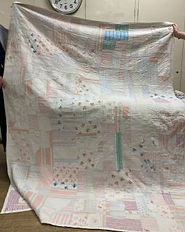Orpington Quilters

Orpington Quilters

At our May 2023 we were entertained by Tony Mansi and his talk on the Canadian Red Cross Quilts that were donated to Europe, but mostly to the UK, during the second world war.
This talk was originally delivered by Tony's late wife, Anna. She and Tony met at medical school in 1961, through their shared interest in art. Tony studied medicine and Anna, dentistry. When Anna retired in 2010 she became more interested in the crafts that she had been surrounded by growing up in a Welsh family. Quilting was a passion and she became a members of The Quilters' Guild.
Anna's first introduction to the Canadian Red Cross Quilts WWII came unexpectedly through her volunteer work at a charity shop, when some quilts were donated with the hallmark "Gift of the Canadian Red Cross Society" and this sparked her interest. Together with Maxine March and Jackie Maxwell, also members of The Quilters' Guild, they decided to research the quilts and build a catalogue of any still in existence. Once the word got out about Anna's endeavours , many donations of quilts were received and the group wanted to display them, with their background story, but this could not be done without the permission of the Canadian High Commission. Authorisation was eventually granted and the research team gave talks and contributed to exhibitions around the country. A book, "Comfort From Kindness" was developed to support an exhibition in Glasgow 2016 of the Canadian Red Cross Quilts. Although Anna and Tony worked extensively on the creation of the book, sadly Anna passed away before it was published. Tony was keen to see all Anna's efforts come to fruition so he took up the mantle of delivering the talk at the exhibition, and he continues spreading the incredible story of these quilts.

Within days of war in Europe being declared in September 1939, the Canadian Red Cross sent a request across the country for quilts to be sent to bomb-risk areas as part of their contribution to the war effort to ease the plight of people struggling with the conditions of war. Already completed quilts could be sent but the majority were created by thousands of Canadian women, using all sorts of available materials, with the battling and backing provided by the Canadian Red Cross.
These quilts were handed out in Britain to those people who had lost everything due to bombing, or those forced to relocate. Some cot quilts were also made for maternity units.
When they arrived in the UK, the quilts were distributed by the Women's Royal Voluntary Service, the Red Cross and the Salvation Army.
Following the ethos of "make do and mend", every scrap of material was used to create the quilts, including shirts, skirts, curtains, fabric samples and swatches, and even feed sacks.
The use of feed sacks was already extensively used in the creation of utility quilts but as you can see from this 1940s advertisement, the distributors of grain and feed soon cottoned on to this idea to increase sales.

The pictures below show the variety of quilts that were made, and the fabrics used. Mostly they were simple quilts, using crazy or stripping techniques, mainly machined with some hand work. Originally there was little embellishment but as the war years went on, that changed.

Nicknamed "Petts Wood Pyjamas" this local quilt was made of old nightwear.

This quilt came from Bickley, created from remnants of dressmaking.

A quilt from Crayford made from swatches of suiting and tweeds.

This quilt used furnishing fabrics, with ties used to join the top, batting and back together,

Made from furnishing fabrics, this quilt is labelled "Dundas", being the area it was created.

This log-cabin quilt is labelled as French-Canadian and dated as 1939 so it's believed to be an already-made quilt that was donated.

Made from tactile fabrics such as velvet, corduroy, etc., this quilt has an embroidered date of 1943.

This is a very fragile 9-patch quilt made from feed bags and cotton sacks.

Made from shirting on both sides, this quilt is labelled "Kitchener", which was THE shirt-making area for Canada.

This quilt is made up of many different blocks. Can you spot Sunbonnet Sam?

This is a very fragile cot quilt donated by a 95 year old lady who had kept it in the airing cupboard once her children had grown. It contains 1200 squares.
This is a signature quilt donated from Swansea. Such quilts were a means of fundraising as people would pay to have their signed name included. The quilt would then be raffled to raise further funds for the war effort.


This quilt was done by hand and is labelled "Quebec Evacuee" so it was actually given in Canada, not in the UK.

The donated quilts were labelled with the name of the area of Canada where they were created.
Everyone at May's meeting really enjoyed Tony's talk and loved hearing about the kindness of strangers at a very difficult time in Britain.
The quilt on the right is not actually a Canadian Red Cross Quilt but a quilt that was created by Anna herself. Whilst exhibiting at a venue, the exhibitor next door asked her for a piece of her own work and she donated "Under African Skies".

Everyone at May's meeting thoroughly enjoyed Tony's talk and were fascinated by this piece of history showing the kindness of strangers at a difficult time for Britain.